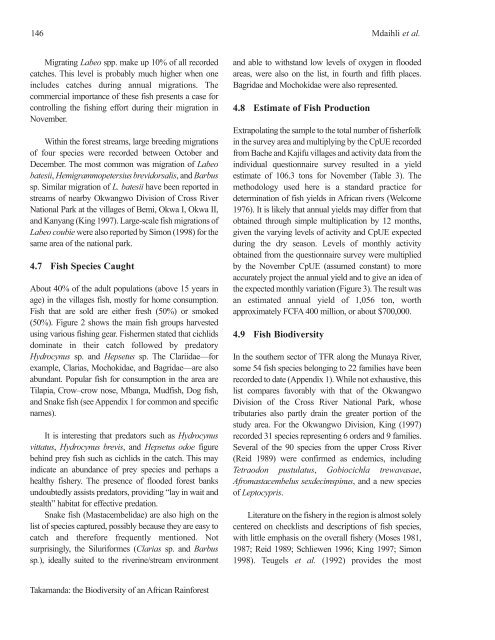Fisheries in the Southern Border Zone of Takamanda - Impact ...
Fisheries in the Southern Border Zone of Takamanda - Impact ...
Fisheries in the Southern Border Zone of Takamanda - Impact ...
Create successful ePaper yourself
Turn your PDF publications into a flip-book with our unique Google optimized e-Paper software.
146<br />
Migrat<strong>in</strong>g Labeo spp. make up 10% <strong>of</strong> all recorded<br />
catches. This level is probably much higher when one<br />
<strong>in</strong>cludes catches dur<strong>in</strong>g annual migrations. The<br />
commercial importance <strong>of</strong> <strong>the</strong>se fish presents a case for<br />
controll<strong>in</strong>g <strong>the</strong> fish<strong>in</strong>g effort dur<strong>in</strong>g <strong>the</strong>ir migration <strong>in</strong><br />
November.<br />
With<strong>in</strong> <strong>the</strong> forest streams, large breed<strong>in</strong>g migrations<br />
<strong>of</strong> four species were recorded between October and<br />
December. The most common was migration <strong>of</strong> Labeo<br />
batesii, Hemigrammopetersius brevidorsalis, and Barbus<br />
sp. Similar migration <strong>of</strong> L. batesii have been reported <strong>in</strong><br />
streams <strong>of</strong> nearby Okwangwo Division <strong>of</strong> Cross River<br />
National Park at <strong>the</strong> villages <strong>of</strong> Bemi, Okwa I, Okwa II,<br />
and Kanyang (K<strong>in</strong>g 1997). Large-scale fish migrations <strong>of</strong><br />
Labeo coubie were also reported by Simon (1998) for <strong>the</strong><br />
same area <strong>of</strong> <strong>the</strong> national park.<br />
4.7 Fish Species Caught<br />
About 40% <strong>of</strong> <strong>the</strong> adult populations (above 15 years <strong>in</strong><br />
age) <strong>in</strong> <strong>the</strong> villages fish, mostly for home consumption.<br />
Fish that are sold are ei<strong>the</strong>r fresh (50%) or smoked<br />
(50%). Figure 2 shows <strong>the</strong> ma<strong>in</strong> fish groups harvested<br />
us<strong>in</strong>g various fish<strong>in</strong>g gear. Fishermen stated that cichlids<br />
dom<strong>in</strong>ate <strong>in</strong> <strong>the</strong>ir catch followed by predatory<br />
Hydrocynus sp. and Hepsetus sp. The Clariidae—for<br />
example, Clarias, Mochokidae, and Bagridae—are also<br />
abundant. Popular fish for consumption <strong>in</strong> <strong>the</strong> area are<br />
Tilapia, Crow–crow nose, Mbanga, Mudfish, Dog fish,<br />
and Snake fish (see Appendix 1 for common and specific<br />
names).<br />
It is <strong>in</strong>terest<strong>in</strong>g that predators such as Hydrocynus<br />
vittatus, Hydrocynus brevis, and Hepsetus odoe figure<br />
beh<strong>in</strong>d prey fish such as cichlids <strong>in</strong> <strong>the</strong> catch. This may<br />
<strong>in</strong>dicate an abundance <strong>of</strong> prey species and perhaps a<br />
healthy fishery. The presence <strong>of</strong> flooded forest banks<br />
undoubtedly assists predators, provid<strong>in</strong>g “lay <strong>in</strong> wait and<br />
stealth” habitat for effective predation.<br />
Snake fish (Mastacembelidae) are also high on <strong>the</strong><br />
list <strong>of</strong> species captured, possibly because <strong>the</strong>y are easy to<br />
catch and <strong>the</strong>refore frequently mentioned. Not<br />
surpris<strong>in</strong>gly, <strong>the</strong> Siluriformes (Clarias sp. and Barbus<br />
sp.), ideally suited to <strong>the</strong> river<strong>in</strong>e/stream environment<br />
<strong>Takamanda</strong>: <strong>the</strong> Biodiversity <strong>of</strong> an African Ra<strong>in</strong>forest<br />
and able to withstand low levels <strong>of</strong> oxygen <strong>in</strong> flooded<br />
areas, were also on <strong>the</strong> list, <strong>in</strong> fourth and fifth places.<br />
Bagridae and Mochokidae were also represented.<br />
4.8 Estimate <strong>of</strong> Fish Production<br />
Extrapolat<strong>in</strong>g <strong>the</strong> sample to <strong>the</strong> total number <strong>of</strong> fisherfolk<br />
<strong>in</strong> <strong>the</strong> survey area and multiply<strong>in</strong>g by <strong>the</strong> CpUE recorded<br />
from Bache and Kajifu villages and activity data from <strong>the</strong><br />
<strong>in</strong>dividual questionnaire survey resulted <strong>in</strong> a yield<br />
estimate <strong>of</strong> 106.3 tons for November (Table 3). The<br />
methodology used here is a standard practice for<br />
determ<strong>in</strong>ation <strong>of</strong> fish yields <strong>in</strong> African rivers (Welcome<br />
1976). It is likely that annual yields may differ from that<br />
obta<strong>in</strong>ed through simple multiplication by 12 months,<br />
given <strong>the</strong> vary<strong>in</strong>g levels <strong>of</strong> activity and CpUE expected<br />
dur<strong>in</strong>g <strong>the</strong> dry season. Levels <strong>of</strong> monthly activity<br />
obta<strong>in</strong>ed from <strong>the</strong> questionnaire survey were multiplied<br />
by <strong>the</strong> November CpUE (assumed constant) to more<br />
accurately project <strong>the</strong> annual yield and to give an idea <strong>of</strong><br />
<strong>the</strong> expected monthly variation (Figure 3). The result was<br />
an estimated annual yield <strong>of</strong> 1,056 ton, worth<br />
approximately FCFA 400 million, or about $700,000.<br />
4.9 Fish Biodiversity<br />
Mdaihli et al.<br />
In <strong>the</strong> sou<strong>the</strong>rn sector <strong>of</strong> TFR along <strong>the</strong> Munaya River,<br />
some 54 fish species belong<strong>in</strong>g to 22 families have been<br />
recorded to date (Appendix 1). While not exhaustive, this<br />
list compares favorably with that <strong>of</strong> <strong>the</strong> Okwangwo<br />
Division <strong>of</strong> <strong>the</strong> Cross River National Park, whose<br />
tributaries also partly dra<strong>in</strong> <strong>the</strong> greater portion <strong>of</strong> <strong>the</strong><br />
study area. For <strong>the</strong> Okwangwo Division, K<strong>in</strong>g (1997)<br />
recorded 31 species represent<strong>in</strong>g 6 orders and 9 families.<br />
Several <strong>of</strong> <strong>the</strong> 90 species from <strong>the</strong> upper Cross River<br />
(Reid 1989) were confirmed as endemics, <strong>in</strong>clud<strong>in</strong>g<br />
Tetraodon pustulatus, Gobiocichla trewavasae,<br />
Afromastacembelus sexdecimsp<strong>in</strong>us, and a new species<br />
<strong>of</strong> Leptocypris.<br />
Literature on <strong>the</strong> fishery <strong>in</strong> <strong>the</strong> region is almost solely<br />
centered on checklists and descriptions <strong>of</strong> fish species,<br />
with little emphasis on <strong>the</strong> overall fishery (Moses 1981,<br />
1987; Reid 1989; Schliewen 1996; K<strong>in</strong>g 1997; Simon<br />
1998). Teugels et al. (1992) provides <strong>the</strong> most

















